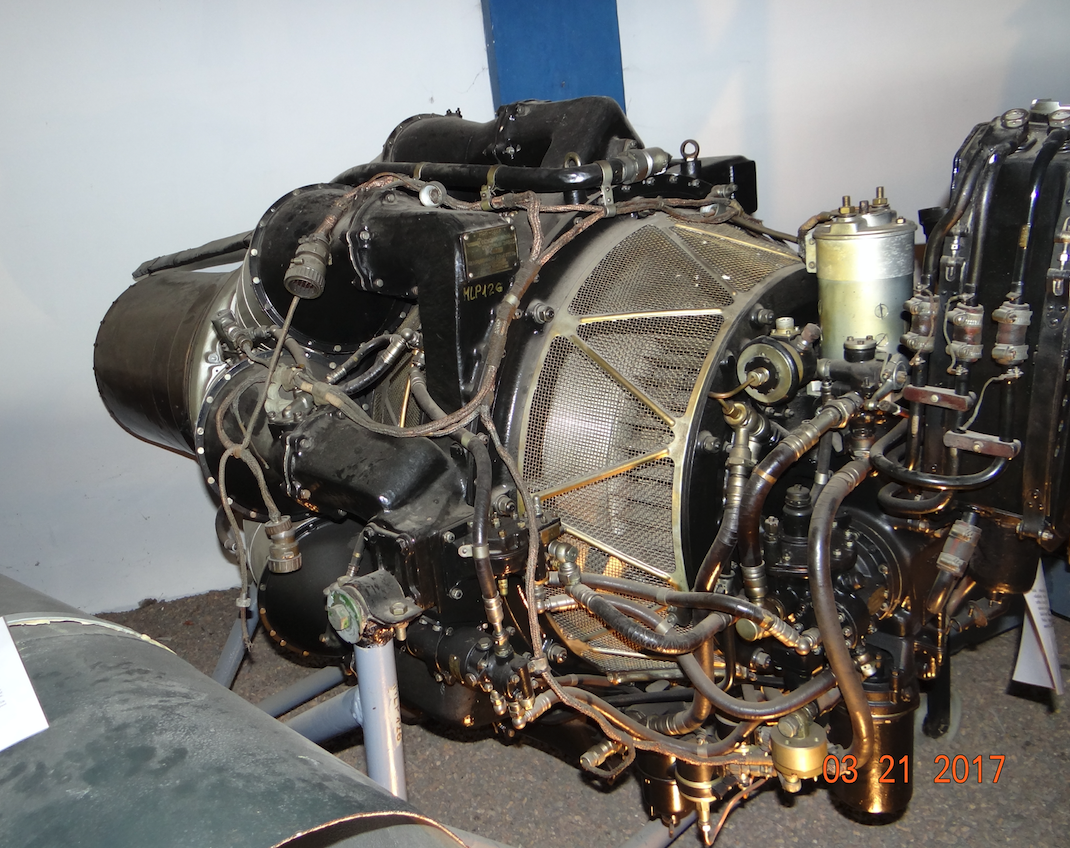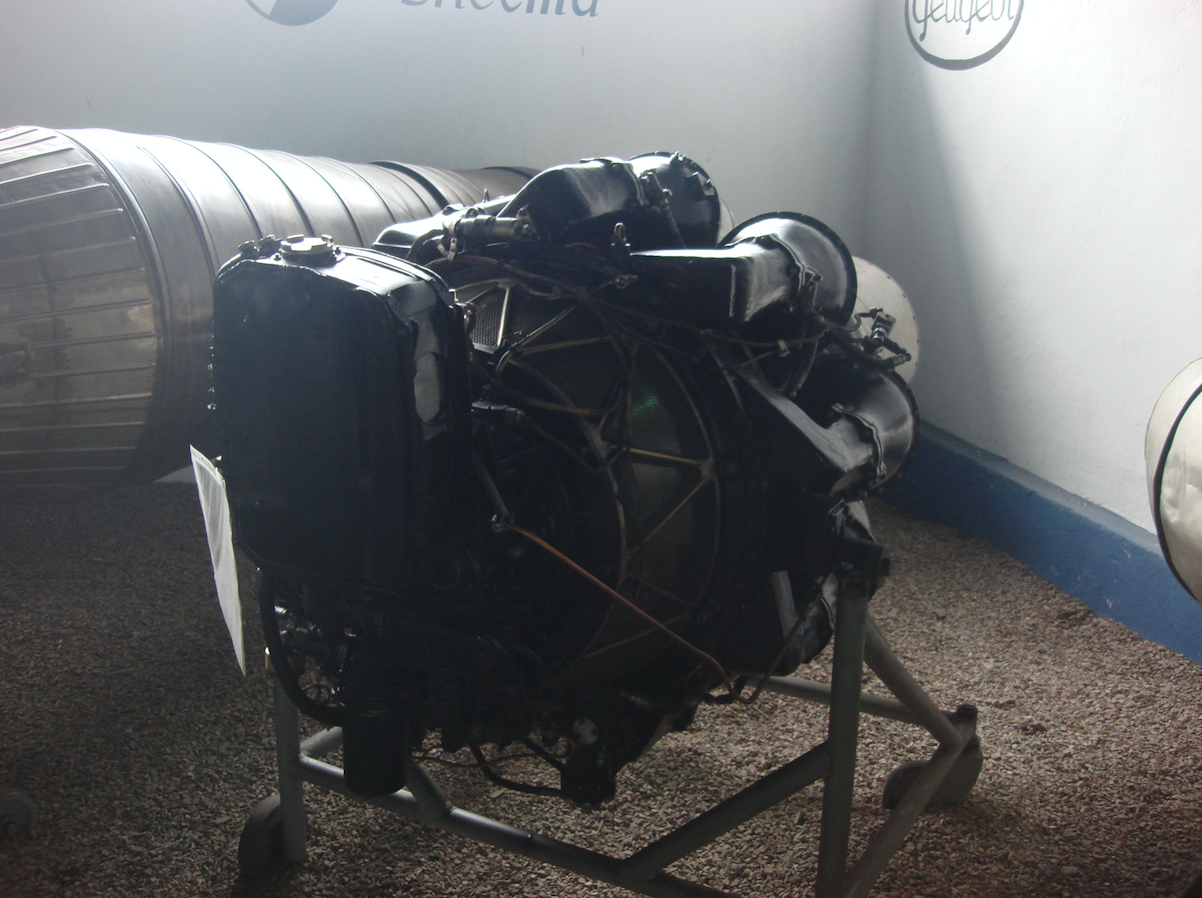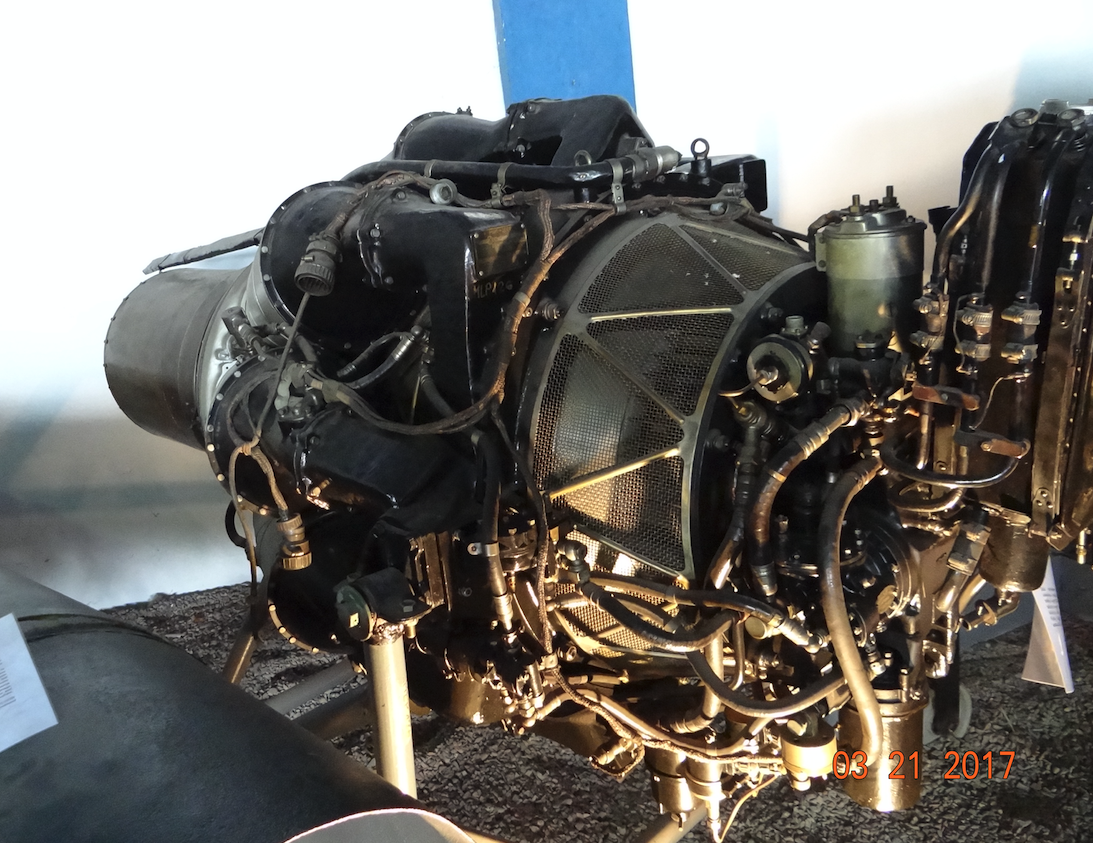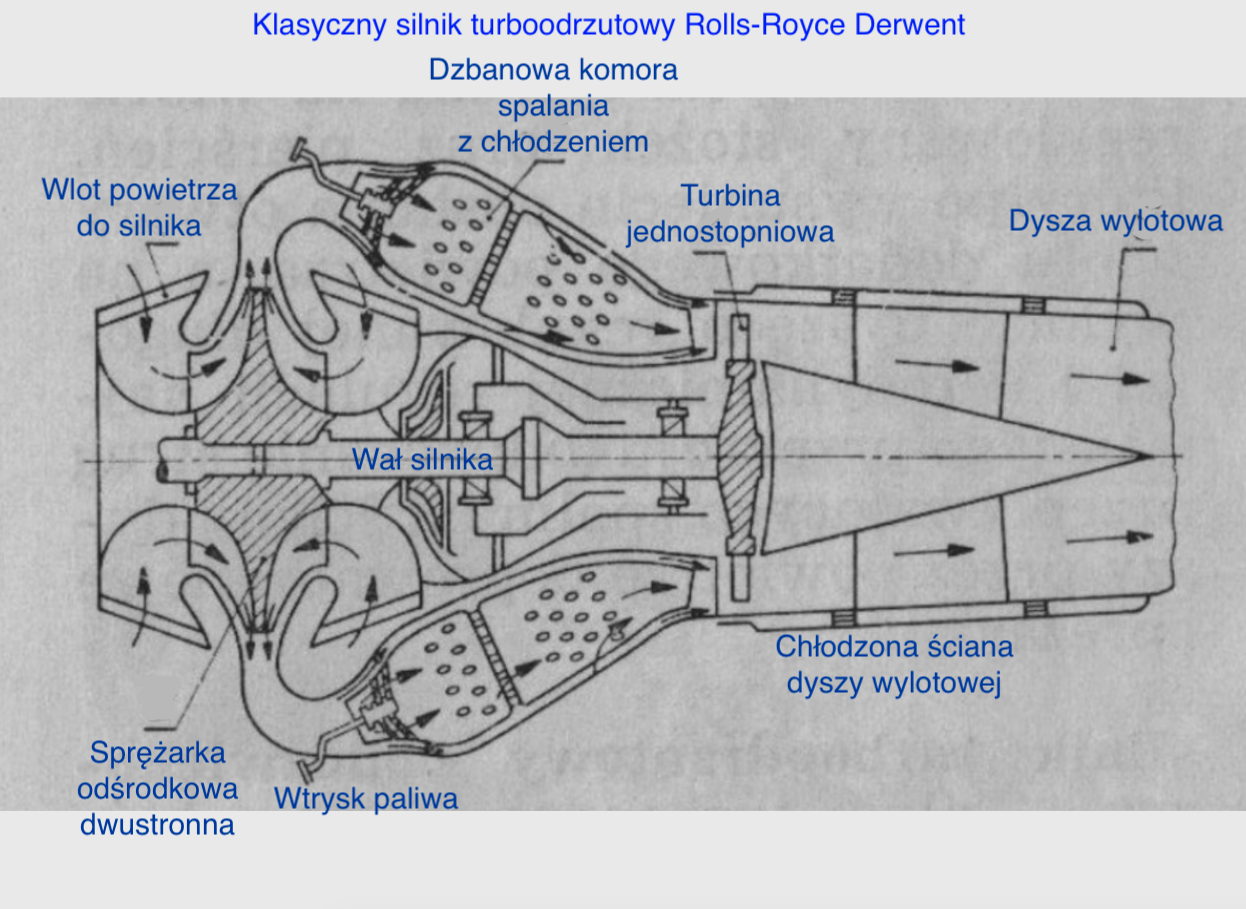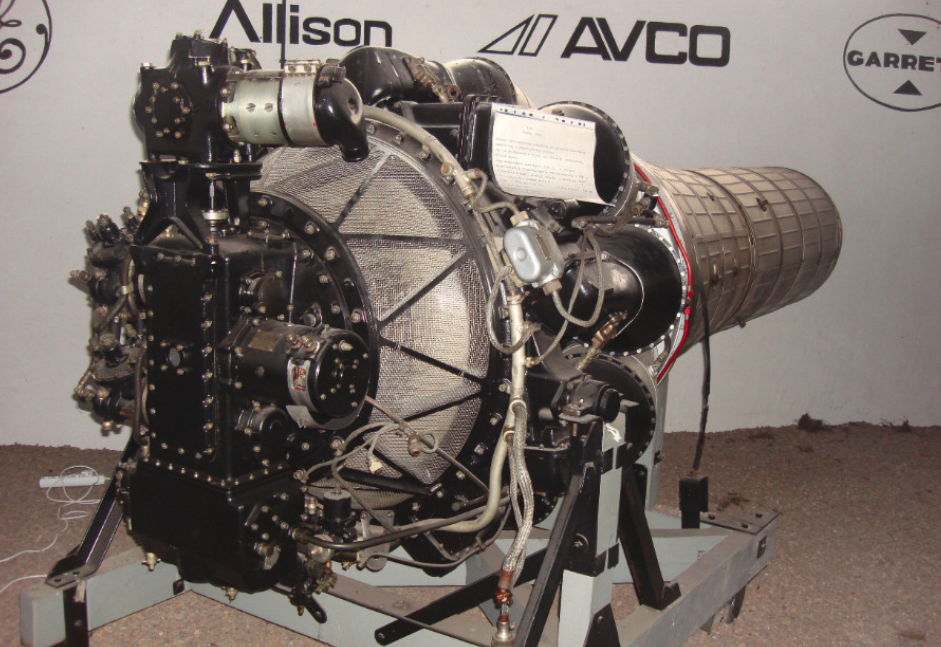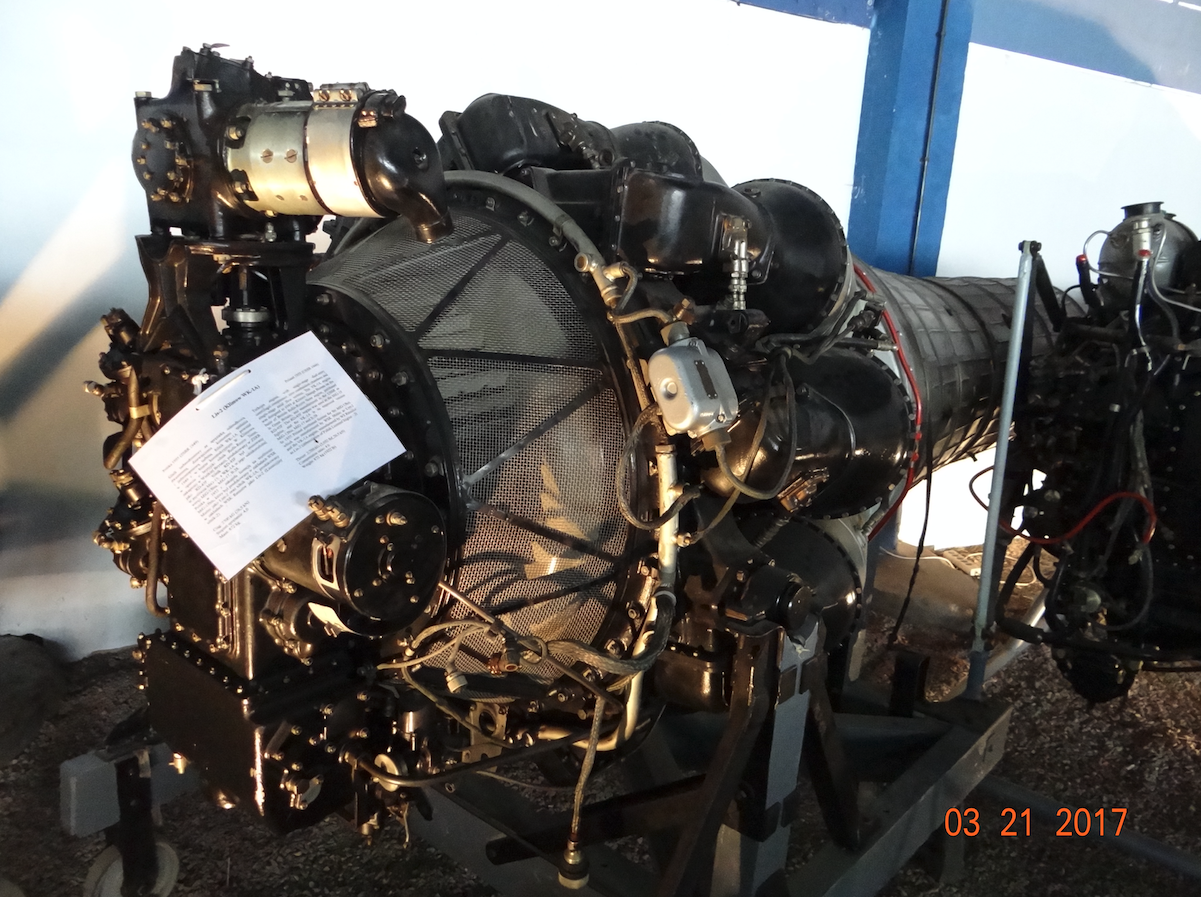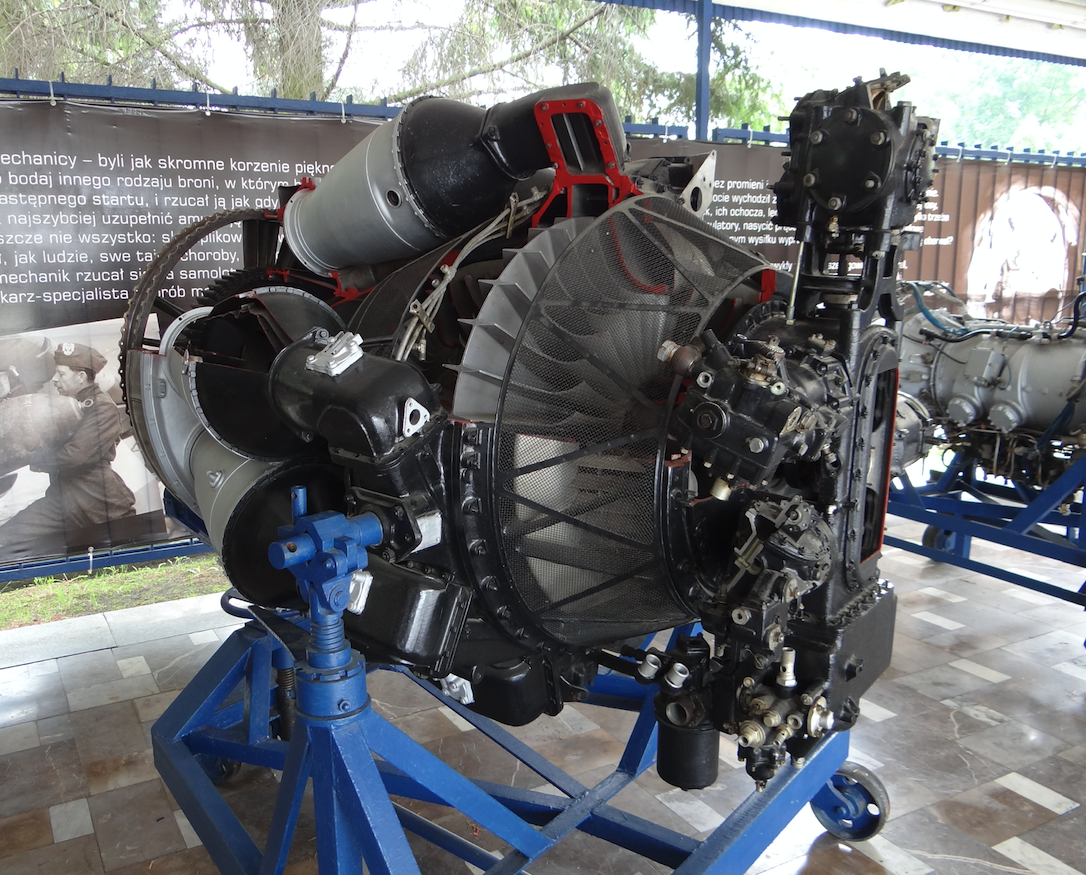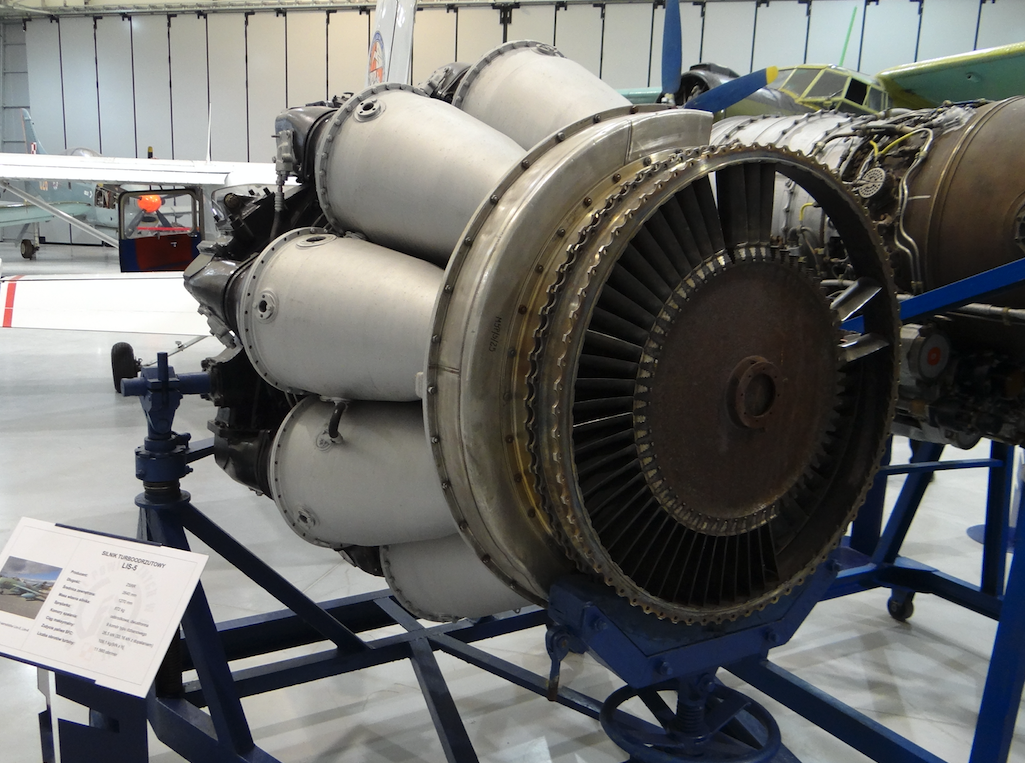Kraków 2020-10-28
Silniki turboodrzutowe RD-500, RD-45.
Artykuł opisuje silniki turboodrzutowe rodziny RD-500 i RD-45, skopiowane przez CCCP z konstrukcji Brytyjskich, a także produkowane seryjnie w Polsce, na podstawie rosyjskiej licencji.
Opis do zdjęcia: Silnik RD-500 produkcji rosyjskiej używany w samolocie myśliwskim Jak-23. Samoloty Jak-23 były na uzbrojeniu Wojska Polskiego, w 50-latach XX wieku.
Silniki RD-500, RD-45. 1947 rok.
Ilość nowych konstrukcji samolotów z napędem turboodrzutowym w CCCP w okresie 1946-1947 była duża. Jednak wszystkie one miały podstawową wadę – niezwykle krótki czas lotu, a przez to mały zasięg. Nawet jak na samoloty frontowe były to parametry trudne do zaakceptowania. W UK i USA osiągnięcia były zdecydowanie lepsze. Dlatego w marcu 1947 roku, przedstawiono nowe wymagania sił powietrznych. Prędkość około-dźwiękowa na dużej wysokości (1 000 km/h), silne uzbrojenie, długotrwałość lotu około 1 godziny, zasięg 1 200 km, kabina hermetyzowana, zastosowanie hamulców aerodynamicznych, zastosowanie podwozia z przednim kołem. Dla spełnienia tych wymagań potrzebny był przede wszystkim nowy silnik. Produkowane seryjnie silniki RD-10 i RD-20 nie byłyby w stanie służyć za napęd nowym konstrukcjom. Także silnik Lulka TR-1 nie odniósł sukcesu.
Sytuację w światowym rozwoju silników turboodrzutowych z uwagą śledził radziecki wywiad. Wszystkie informacje trafiały do Artioma Iwanowicza Mikojana, sławnego już wówczas konstruktora lotniczego i obok Jakowlewa ulubieńca Stalina. Mało tego. Artioma Mikojana był bratem Anastasa Mikojana, członka biura politycznego, który był prawą ręką Stalina, a potem wiernym poddanym Chruszczowa. W 1946 roku, firma Rolls-Royce wystawiła na sprzedaż swoje silniki Derwent V i Nene I/II. W dniu 17 czerwca 1946 roku, wyszło postanowienie rady ministrów CCCP umożliwiające zakup tych silników w UK. Wówczas wysłano do Wielkiej Brytanii delegację. W jej składzie byli: Artiom Iwanowicz Mikojan – konstruktor samolotów, Władimir Jakowlewicz Klimow – konstruktor silników, S. T. Kiszkin – technolog-metalurg. Delegacja przebywała w Anglii od 3.12.1946 roku do 22.12.1946 roku. (Władimir Klimow pozostał tam aż do 1.02.1947 roku). Nie oczekiwano wiele. Stosunki niedawnych sojuszników pogarszały się. Jednak Anglikom zależało na sprzedaży silników. Rosjanie odwiedzili zakłady: Bristol, de Havilland, English Electric, Gloster, Metropolita-Vickers, Rolls-Royce i Vickers-Armstrong. Szczegółowy raport został przedstawiony biuru politycznemu komitetu centralnego komunistycznej partii związku radzieckiego, w skrócie biuro polityczne KC CCCP lub inaczej „politbiuro”, w dniu 10 stycznia 1947 roku. Zawarto w nim informacje o dużych środkach finansowych inwestowanych w rozwój silników turboodrzutowych. Przedstawiano sukces żarowytrzymałego nadstopu Nimonic-80. Wskazywano na niezawodność i długą żywotność pracy silników Derwent V i Nene I. Wskazywano na łatwość eksploatacji i remontów. Zapisano także, że osiągnięcia niemieckie były daleko skromniejsze niż aktualne sukcesy brytyjskie.
Silnik RD-500.
W takiej sytuacji za wszelką cenę należało zakupić te silniki, albo pozyskać je w innych krajach, a następnie skopiować. W materiałach partyjnych nie kryto, że planowano kopiowanie silników, bez zakupu licencji. Umowa zakupu została zatwierdzona przez CCCP w dniu 11 marca 1947 roku. W dniu 21 marca 1947 roku, pierwsze 10 silników Derwent V wyruszyło statkiem z Anglii do Murmańska. Kolejna dostawa: 20 sztuk Derwent V (ciąg 15,6 kN, resurs między remontowy 125 godzin) i 15 sztuk Nene I (ciąg 22,3 kN) dopłynęła do Murmańska w listopadzie 1947 roku. Według innych danych kupiono 30 silników Derwent V i 25 sztuk Nene I/II.
Znacznie wcześniej, bo już w dniu 15 lutym 1947 roku, podjęto tajną decyzję o skopiowaniu silników Derwent V i Nene I/II. Licencji Rosjanom nie sprzedano, ale w ich ręce dostała się dokumentacja silników uzyskana przez wywiad. To, iż silniki te zostały skopiowane bez licencji odkryto w 1958 roku, podczas wizyty w Pekinie pilota Whitney Straight, który oglądał tam samolot MiG-15. Był on wówczas w zarządzie koncernu Roll-Royce. Postanowił on pozwać rząd CCCP do sądu, z żądaniem odszkodowania za naruszenie praw w wysokości 200 mil £, do czego nigdy nie doszło.
Przeglądając obecne angielskie fora internetowe, daje się zauważyć krytykę powojennego rządu UK za tę sprzedaż. Uważa się, że CCCP potrzebowałby co najmniej pięciu lat na stworzenie silnika na miarę Rolls-Royce Nene, a przez to nie byłoby takiego myśliwca jak MiG-15. Ich pierwszy silnik Lulka TR-1 okazał się nieudany. Należy tu jednak nadmienić, że zakupione silniki były używane w tym czasie w lotnictwie kilku państw. Nie były, więc to konstrukcje tajne. Sprzedaż była gestem dobrej woli do wykorzystania pozamilitarnego, co osobiście uważamy za dużą naiwność Brytyjczyków. Tego błędu Wielka Brytania już nigdy nie powtórzyła. Z drugiej strony, nie wiadomo, czy rosjanie nie zdobyliby tych silników w inny sposób, w innym kraju.
Mikojan dla swojego przyszłego myśliwca wybrał silnik mocniejszy, ale przez to cięższy. Długo trwał wybór koncepcji przyszłego samolotu. Na pewno jednak Mikojan chciał uniknąć kłopotów, które towarzyszyły myśliwcowi MiG-9. Zrezygnował z układu dwu silnikowego. Zrezygnował z dyszy wylotowej pod kadłubem, uznając to za nieperspektywiczne. Długo utrzymywał koncepcję zbliżoną do angielskiego Vampir, ale ze skośnym skrzydłem. Co do skrzydeł, to nie miał najmniejszych wątpliwości. Miały być skośne.
Silnik Rolls Royce Derwent V, miał bardzo korzystny stosunek ciągu do masy, co predysponowało go jako napęd lekkich samolotów myśliwskich mających dużą prędkość wznoszenia (współczynnik ciągu do ciężaru wynosił 0,0316 kN/kg lub inaczej 31,871 kg/kN). Ciąg max 17,79 kN przy 15 000 obrotów/min na poziomie morza. (Bieg jałowy 0,53 kN przy 5 500 obr/min). Ma długość 2,249 m (88,5 in), średnicę 1,092 m (43 in), masę 567 kg (1 250 lb). Sprężarka jednostopniowa, dwustronna, odśrodkowa, o sprężu 3,9:1. 10-dzbanowych komór spalania. Jedno-stopniowa turbina. Temperatura gazów przed turbiną 849 stopni C. Paliwo – nafta lotnicza (kerozyna) typ R.D.E.F./F/KER. Zużycie paliwa 103,97 kg/kN/h. Układ olejowy z chłodzeniem i filtracją oleju.
W CCCP silnikiem Rolls Royce Derwent V zajęła się grupa Władimira Klimowa. Silnik otrzymał oznaczenie Klimow RD-500. Angielską dokumentację przygotowano do radzieckich technologii produkcyjnych i materiałów. Pierwsze uruchomienie silnika nastąpiło w dniu 31.12.1947 roku. Silnik stał się podstawowym napędem samolotu Jak-23. Samoloty Jak-23 były eksploatowane w Polsce. W CCCP zbudowano około 859 sztuk silników Klimow RD-500.
Problemem silników RD-500 okazało się brak oryginalnego stopu Nimonic-80, który został opracowany w 1940 roku, w zespole badawczym Wiggin Works w Hereford w Anglii specjalnie dla silników Frank Whittle. Nimonic-80 jest wysokotemperaturowym nadstopem charakteryzującym się niską wartością pełzania. Pełzanie jest to powolna zmiana kształtu materiału (odkształcanie) wskutek działania stałych, długotrwałych obciążeń, mniejszych od granicy sprężystości materiału. Pełzanie przebiega znacznie szybciej w wysokich temperaturach. Nimonic-80 jest stopem opartym na niklu (około 50 %) i chromie (około 20 %) z dodatkami takimi jak tytan i aluminium. Rosjanie zastosowali stop KhN 80T, który znacznie szybciej ulegał odkształceniom, z powodu wysokiego współczynnika pełzania.
Silnik RD-500 trapiły jeszcze inne poważne problemy. Nierównomierne spalanie oraz pękanie komór spalania. Nierówne spalanie było wynikiem modyfikacji (uproszczenia) układu paliwowego wykonanego przez sowieckich inżynierów. Rosjanie dokonali jeszcze jednej poważnej zmiany w budowie silnika. Zamiast 10-dzbanowych komór spalania zastosowali 9-dzbanowych komór spalania nieco większych. To było początkowo powodem ich pękania. Kłopoty w miarę rozwiązano we wrześniu 1948 roku, kiedy to silnik przeszedł pomyślnie państwowy test 100-godzinnej ciągłej pracy. Uznano wówczas, że silnik można dopuścić do eksploatacji z resursem między naprawczym 100 godzin.
Silnik Klimow RD-500 w stosunku do silnika Rolls Royce Derwent V miał niższy ciąg aż o 1,89 kN. RD-500 ciąg 1 x 15,90 kN (1 x 1 590 daN) przy 14 700 obr/min (245 obr/s) na poziomie morza. Ma identyczną średnicę (1,09 m), ale jest nieco krótszy z powodu krótszej dyszy wylotowej (2,06 m). Jednak ma większą masę o 14 kg (581 kg). Miał także większe zużycie paliwa 140 kg/kN/h, z uwagi na gorszą jego jakość wykonania. W efekcie współczynnik ciągu do ciężaru wynosił 0,0273 kN/kg lub inaczej 36,540 kg/kN.
W trakcie produkcji silników Klimow RD-500 głównym problemem były wadliwe odlewy łopatek turbiny. Ponad 30 % odlewów odrzucano. Z kolei w trakcie eksploatacji, łopatki wykonane ze stopu KhN 80T wydłużały się i dochodziło do uszkodzenia turbiny. Rzadko kiedy silniki RD-500 przepracowywały deklarowane 100 godzin pracy między remontowej.Rosjanie mieli także duże problemy z organizacją pracy podczas produkcji silników RD-500. W 1947 roku, początkowo dla wykonania jednego silnika potrzeba było aż 20 000 osobo-godzin. Liczba ta spadła do akceptowalnych 7 900 osobo-godzin w listopadzie 1947 roku. W marcu 1949 roku, osiągnięto 4 700 osobo-godzin. Fabryka Nr 500 w 1948 roku, zbudowała 97 silników, a w 1949 roku 462. Produkcję umieszczono także w fabryce Nr 16 w Kazaniu, gdzie w 1949 roku, zbudowano około 300 silników RD-500. Łącznie zbudowano 859 sztuk silników. Produkcja silników Klimow RD-500 została wstrzymana w 1950 roku, na rzecz silników Klimow WK-1 budowanych w oparciu o silnik Rolls-Royce Nene. W CCCP silnik Klimow RD-500 został wykorzystany do napędu samolotów; Jakowlewa Jak-23, Jak-25, Jak-30, Jak-1000, Ławoczkin Ła-15, Mikojan i Guriewicz KSK, Raduga KS-1 Komet. Silnik Klimow RD-500 został skopiowany w Chinach i rozwijany w zakładach Shenyang Aircraft Development Office PF-1A.
Silnik RD-45.
Drugim silnikiem zdobytym w Anglii był Rolls Royce Nene. Były to w zasadzie dwa silniki Rolls-Royce Nene Mk 1 i Mk 2, które były pierwszymi wersjami tej rodziny. Rolls-Royce Nene należy do trzeciej serii silników turboodrzutowych ze sprężarką odśrodkową po liniach rozwojowych Wellend i Derwent budowanych w zakładach Rolls-Royce. Silniki te zostały wyparte przez silniki rodziny Avon ze sprężarkami osiowymi. Silnik Rolls-Royce Nene były stosowane na samolotach Avro Lancastrain w miejscu dwóch zewnętrznych silników tłokowych typu Merlin. Stosowano je także na samolocie Lockheed XP-80 Shoting Star. W 1947 roku, licencyjną produkcję podjęto w USA w zakładach Pratt and Whitney pod oznaczeniem J-42 i użyto do napędu między innymi myśliwców pokładowych Grumman F9F Phanter. Silniki Rolls-Royce Nene oraz Pratt and Whitney J-42 użyto do napędu ponad 25 konstrukcji lotniczych.
Silnik Rolls-Royce Nene I/II w porównaniu z Rolls-Royce Derwent V został znacznie powiększony. Jego pierwsze uruchomienie nastąpiło w 1944 roku. Silnik Rolls Royce Nene otrzymał 9-dzbanowych komór spalania. Ciąg 1 x 22,24 kN przy 12 300 obr/min na poziomie morza. (Bieg jałowy 0,53 kN przy 2 500 obr/min). Wymiary silnika; długość 2,458 m (96,8 in), średnica 1,257 m (49,5 in), masa 726 kg. Współczynnik ciągu do ciężaru wynosi 0,0306 kN/kg lub inaczej 32,643 kg/kN. Są to gorsze parametry od silnika Derwent V, jednak większy ciąg jest nie do przecenienia. Paliwo – nafta lotnicza (kerozyna) typ R.D.E.F./F/KER. Zużycie paliwa 108,04 kg/kN/h. Układ olejowy z chłodzeniem i filtracją oleju. Turbina silnika napędza jednocześnie prądnice i sprężarkę wysokościową.
Silnik Rolls-Royce Nene w CCCP otrzymał oznaczenie RD-45 bo był produkowany w fabryce Nr 45. Produkcję podjęto także w zakładzie GAZ 116. Początkowo silniki RD-45 trapiły te same problemy co silniki RD-500.
W dniu 30 grudnia 1947 roku, oblatano myśliwiec MiG-15, napędzany silnikiem RD-45 F, a niedługo po nim, w dniu 8 stycznia 1948 roku, myśliwiec Ła-15 (Ła-174), z silnikiem RD-500. Samoloty te zbudowane były w nowoczesnym układzie ze skośnymi skrzydłami i miały podobne wysokie osiągi (MiG-15 – prędkość 1047 km/h, Ła-15 – 1026 km/h). MiG-15 trafił do wielkoseryjnej produkcji, stając się najliczniejszym samolotem odrzutowym w historii (około 12 000 wszystkich wersji oraz kilka dalszych tysięcy licencyjnych), natomiast Ła-15 został zbudowany w ograniczonej ilości, dla jednego pułku myśliwskiego. Jeszcze przed nimi w biurze OKB Jakowlewa opracowano samolot Jak-25, oblatany w dniu 31 października 1947 roku (pierwszy o tej nazwie), lecz na skutek zastosowania prostych skrzydeł, miał on słabsze osiągi i nie wszedł do produkcji seryjnej.
Silnik Klimow RD-45 wydał się Rosjanom bardziej perspektywiczny, z uwagi na większy ciąg, mimo większych wymiarów i masy. Dlatego przystąpiono do jego modyfikacji. Zwiększono wielkość dzbanowych komór spalania, powiększono turbinę i zwiększono przepływ powietrza przez silnik z 41 kg/s do 45 kg/s. Tak powstał silnik WK-1 (Władimir Klimow), który nieco później otrzymał dopalacz. Zmieniono oznaczenie WK-1 F. Silnik WK-1 stał się napędem samolotów MiG-15 bis, Ił-28, a silnik WK-1 F samolotów MiG-17.
Silnik WK-1 ma wymiary; długość 2,60 m, średnicę 1,30 m, masę 872 kg. Sprężarka odśrodkowa, dwustronna. Spręż 3,1:1. Ciąg max 26,5 kN (2 702 kG) przy 13 000 obr/min na poziomie morza. Zużycie paliwa 109,1 kg/ kN·h. Współczynnik ciągu do ciężaru wynosi 0,0303 kN/kg lub inaczej 32,95 kg/kN.
Produkcja w Polsce silników Lis-1, Lis-2, Lis-5. 1955 rok.
Silnik RD-45 F był produkowany w Polsce w WSK PZL Rzeszów pod oznaczeniem Lis-1. Oznaczenie Lis to skrót od – licencyjny silnik. Polska za licencję Rosjanom zapłaciła, a jak jest napisane powyżej, CCCP za licencje Brytyjczykom nie zapłacił. Licencja została kupiona w 1955 roku. Silnik Lis-1 dysponuje ciągiem 1 x 22,25 kN (1 x 2 270 kG). Jednak stosunkowo szybko silnik ten na linii produkcyjnej został zastąpiony silnikiem WK-1, który w WSK PZL Rzeszów oznaczono Lis-2.
Podstawowe dane silnika Lis-2: Produkcja w WSK PZL Rzeszów. Ciąg maksymalny 26,5 kN (2 700 kG), przy 11 600 obrotach na minutę. Stopień sprężenia 4,0:1. Masa silnika 872 kg. Silnik ma sprężarkę odśrodkową dwustronną, 9 komór spalania, jednostopniową turbinę. Temperatura za turbiną wynosi 720 stopni C. Zużycie paliwa 1 050 g/h/kG.
Po uruchomieniu w Polsce produkcji samolotów myśliwskich Lim-5 (MiG-17 F) i Lim-5 P (MiG-17 FP), również dla tego samolotu uruchomiono produkcję silników WK-1 z dopalaczem. W Polsce silnik otrzymał oznaczenie Lis-5. Silnik ten posłużył także do napędu samolotów Polskiej konstrukcji Lim-6.
Silnik Lis-5 o ciągu 1 x 26,46 kN (1 x 2 700 kG), a z dopalaniem 1 x 33,12 kN (1 x 3 380 kG). Dopalacz połączony jest z silnikiem i stanowi przedłużoną i odpowiednio uformowaną rurę wylotową. Umieszczono tam zestaw wtryskiwaczy, przez które dostarczane jest dodatkowe paliwo, a jego spalenie wywołuje wzrost ciągu. Paliwo do silnika podaje pompa PCR-1-5.
Podstawowe dane silnika Lis-5: Produkcja w WSK PZL Rzeszów. Konstrukcja identyczna z silnikiem Lis-2, tylko dodano dopalacz. Ciąg bez dopalania wynosi 2 650 kG przy 11 560 obrotach na minutę. Ciąg z dopalaniem wynosi 3 380 kG przy 11 560 obrotach na minutę. Masa silnika 978 kg. Zużycie paliwa bez dopalania 1,5 kg/kG/h. Zużycie paliwa z dopalaniem 1,8-2,0 kg/kG/h.
Opracował Karol Placha Hetman

